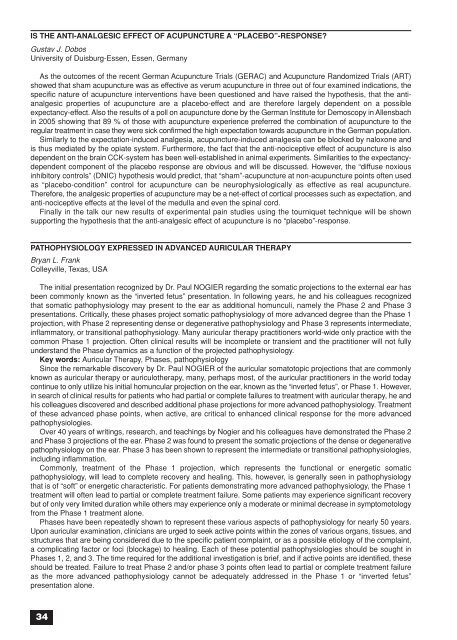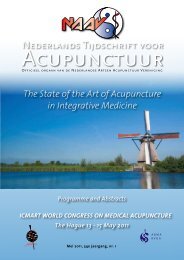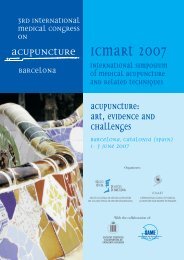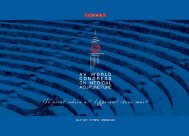Congress Abstracts full PDF - International Council of Medical ...
Congress Abstracts full PDF - International Council of Medical ...
Congress Abstracts full PDF - International Council of Medical ...
Create successful ePaper yourself
Turn your PDF publications into a flip-book with our unique Google optimized e-Paper software.
IS THE ANTI-ANALGESIC EFFECT OF ACUPUNCTURE A “PLACEBO”-RESPONSE<br />
Gustav J. Dobos<br />
University <strong>of</strong> Duisburg-Essen, Essen, Germany<br />
As the outcomes <strong>of</strong> the recent German Acupuncture Trials (GERAC) and Acupuncture Randomized Trials (ART)<br />
showed that sham acupuncture was as effective as verum acupuncture in three out <strong>of</strong> four examined indications, the<br />
specific nature <strong>of</strong> acupuncture interventions have been questioned and have raised the hypothesis, that the antianalgesic<br />
properties <strong>of</strong> acupuncture are a placebo-effect and are therefore largely dependent on a possible<br />
expectancy-effect. Also the results <strong>of</strong> a poll on acupuncture done by the German Institute for Demoscopy in Allensbach<br />
in 2005 showing that 89 % <strong>of</strong> those with acupuncture experience preferred the combination <strong>of</strong> acupuncture to the<br />
regular treatment in case they were sick confirmed the high expectation towards acupuncture in the German population.<br />
Similarly to the expectation-induced analgesia, acupuncture-induced analgesia can be blocked by naloxone and<br />
is thus mediated by the opiate system. Furthermore, the fact that the anti-nociceptive effect <strong>of</strong> acupuncture is also<br />
dependent on the brain CCK-system has been well-established in animal experiments. Similarities to the expectancydependent<br />
component <strong>of</strong> the placebo response are obvious and will be discussed. However, the “diffuse noxious<br />
inhibitory controls” (DNIC) hypothesis would predict, that “sham”-acupuncture at non-acupuncture points <strong>of</strong>ten used<br />
as “placebo-condition” control for acupuncture can be neurophysiologically as effective as real acupuncture.<br />
Therefore, the analgesic properties <strong>of</strong> acupuncture may be a net-effect <strong>of</strong> cortical processes such as expectation, and<br />
anti-nociceptive effects at the level <strong>of</strong> the medulla and even the spinal cord.<br />
Finally in the talk our new results <strong>of</strong> experimental pain studies using the tourniquet technique will be shown<br />
supporting the hypothesis that the anti-analgesic effect <strong>of</strong> acupuncture is no “placebo”-response.<br />
PATHOPHYSIOLOGY EXPRESSED IN ADVANCED AURICULAR THERAPY<br />
Bryan L. Frank<br />
Colleyville, Texas, USA<br />
The initial presentation recognized by Dr. Paul NOGIER regarding the somatic projections to the external ear has<br />
been commonly known as the “inverted fetus” presentation. In following years, he and his colleagues recognized<br />
that somatic pathophysiology may present to the ear as additional homunculi, namely the Phase 2 and Phase 3<br />
presentations. Critically, these phases project somatic pathophysiology <strong>of</strong> more advanced degree than the Phase 1<br />
projection, with Phase 2 representing dense or degenerative pathophysiology and Phase 3 represents intermediate,<br />
inflammatory, or transitional pathophysiology. Many auricular therapy practitioners world-wide only practice with the<br />
common Phase 1 projection. Often clinical results will be incomplete or transient and the practitioner will not <strong>full</strong>y<br />
understand the Phase dynamics as a function <strong>of</strong> the projected pathophysiology.<br />
Key words: Auricular Therapy, Phases, pathophysiology<br />
Since the remarkable discovery by Dr. Paul NOGIER <strong>of</strong> the auricular somatotopic projections that are commonly<br />
known as auricular therapy or auriculotherapy, many, perhaps most, <strong>of</strong> the auricular practitioners in the world today<br />
continue to only utilize his initial homuncular projection on the ear, known as the “inverted fetus”, or Phase 1. However,<br />
in search <strong>of</strong> clinical results for patients who had partial or complete failures to treatment with auricular therapy, he and<br />
his colleagues discovered and described additional phase projections for more advanced pathophysiology. Treatment<br />
<strong>of</strong> these advanced phase points, when active, are critical to enhanced clinical response for the more advanced<br />
pathophysiologies.<br />
Over 40 years <strong>of</strong> writings, research, and teachings by Nogier and his colleagues have demonstrated the Phase 2<br />
and Phase 3 projections <strong>of</strong> the ear. Phase 2 was found to present the somatic projections <strong>of</strong> the dense or degenerative<br />
pathophysiology on the ear. Phase 3 has been shown to represent the intermediate or transitional pathophysiologies,<br />
including inflammation.<br />
Commonly, treatment <strong>of</strong> the Phase 1 projection, which represents the functional or energetic somatic<br />
pathophysiology, will lead to complete recovery and healing. This, however, is generally seen in pathophysiology<br />
that is <strong>of</strong> “s<strong>of</strong>t” or energetic characteristic. For patients demonstrating more advanced pathophysiology, the Phase 1<br />
treatment will <strong>of</strong>ten lead to partial or complete treatment failure. Some patients may experience significant recovery<br />
but <strong>of</strong> only very limited duration while others may experience only a moderate or minimal decrease in symptomotology<br />
from the Phase 1 treatment alone.<br />
Phases have been repeatedly shown to represent these various aspects <strong>of</strong> pathophysiology for nearly 50 years.<br />
Upon auricular examination, clinicians are urged to seek active points within the zones <strong>of</strong> various organs, tissues, and<br />
structures that are being considered due to the specific patient complaint, or as a possible etiology <strong>of</strong> the complaint,<br />
a complicating factor or foci (blockage) to healing. Each <strong>of</strong> these potential pathophysiologies should be sought in<br />
Phases 1, 2, and 3. The time required for the additional investigation is brief, and if active points are identified, these<br />
should be treated. Failure to treat Phase 2 and/or phase 3 points <strong>of</strong>ten lead to partial or complete treatment failure<br />
as the more advanced pathophysiology cannot be adequately addressed in the Phase 1 or “inverted fetus”<br />
presentation alone.<br />
34







